IMPACT OF COVID19 ON MANHATTAN RETAIL
“Just a perfect day
Feed animals in the zoo
Then later
A movie, too, and then home.” (Lou Reed)
At Eixos we’ve used our fieldwork data to shed light on the current business scenario and what has yet to come as a result of the closure of business. We do not do this to be alarmists, but because we believe that it is possible to make more accurate forecasts and make better decisions with data-driven scenarios.
In the coming days, weeks and months we will be publishing a series of articles that analyze the impact of confinement and social distancing measures on retail and economic activities at the street level of cities.
How does confinement and social distancing affect retail? How will it affect it in the next few months? How will our urban retail be doing in a year? What steps should be taken to revive the likely drop in business activity?
These and others will be questions that we will try to answer using data, and retail composition and retail health indicators.
We dedicated the first article of the series to evaluate the covid19 quarantine on Barcelona retail. In many aspects Barcelona and Manhattan could be considered twins. Both have their ground level covered with a very continuous carpet of retail stores. You can find a row of shops on every street, in every direction. in a “grid” model.
Both are based on what we refer to as a “mediterranean model of city” (as opposed to a “high street” or “main street” model) that combines retail and other commercial services on the ground level with residential or business offices on top of it. They also share a similar geographical size (around 50 km2). Both have almost 3,000 restaurants, almost the same number of convenience stores, around 1,200 Manhattan Delis vs. 1,300 Barcelona “Pakis”). And so on.
CONFINEMENT AND CLOSURES. BEFORE, DURING AND AFTER.
How do we measure the impact of retail closure?
We will do this by comparing four scenarios with each other: the pre-closure scenario, the scenario during the lockdown itself (both real and quantifiable scenarios), and two hypothetical post-lockdown scenarios, three months after the end of confinement.
In order to create the hypothetical scenarios, we suppose that certain commercial activities, due to their specific characteristics, will have problems reopening. In one way or another, all commercial activities will suffer through financial stress. However, some businesses will have to permanently close and these closures will be the most damaging.
As modeling retail closures can become a very complex calculation, which would require data on which we cannot have sufficient detail (such as debt status, actual operating costs, etc.), we simplify the model by assuming what would happen if certain categories of economic activity simply could not reopen after the lockdown.
We also establish the margins of different commercial scenarios that would lead to decay in activity. The key here is predicting when the Retail Occupancy Index (ROI) (the percentage of active storefronts with respect to the total number of available storefronts in a particular geographical area) might fall below the threshold of desertification (ROI < 80) and below the even more critical threshold of severe desertification (ROI < 70).
Red dots: All stores open normally before lockdown.
What activities are most affected?
One group of stores that might be most affected are stores with goods in stock that may be damaged or hard to sell after the lockdown period They are generally also small businesses that are not very liquid and cannot survive extended periods of time without revenues.
They are labor intensive –> 5 to 6 workers / 100 m2
They are labor intensive –> 5 to 6 workers / 100 m2
Apparel –> Clothing, shoe’s, etc.
They currently have stock that will be out of style by the time they can reopen and will probably have to sell at huge discounts to move their existing stock.
Food & beverage -> Bars, restaurants.
Even though Manhattan has a lot of restaurants that are staying open to run delivery service during the lockdown, their revenues are significantly reduced and they are assumed to be closed during the lockdown for purposes of calculating the Retail Occupancy Index. On the other hand, in our hypothetical doomsday scenario after the lockdown (described later) we’ve assumed only 50% of them reopen.
Another group of stores that are significantly affected during the lockdown are those that depend on tourism, especially those in the most touristy areas of the city.
Right: concentration map of hotel and restaurant activities.
DEFINITION OF SCENARIOS
Pre-lockdown scenario
Based on the store-by-store inventory Eixos conducted in the summer of 2019 of every retail space in Manhattan, we know that the average retail occupancy in Manhattan was 90.46% (ROI = 90.46). See our report for more detail on the retail scenario as of the summer of 2019.
Covid19 Scenario
Only the essential activities are open:
During the lockdown, only the essential activities are open:
food, groceries and pharmacies. retail occupancy is below 30% (ROI 26.60)
Medium impact scenario (m)
All activities reopen after the lockown except apparel stores.
Average retail occupancy in Manhattan is slightly over 80% (ROI 81.91) in this scenario.
DoomsDay scenario (dd)
After the lockdown all activities are open except apparel stores, and 50 percent of bars and restaurants.
Average retail occupancy in Manhattan is slightly below 70% (ROI 69.91) in this scenario.
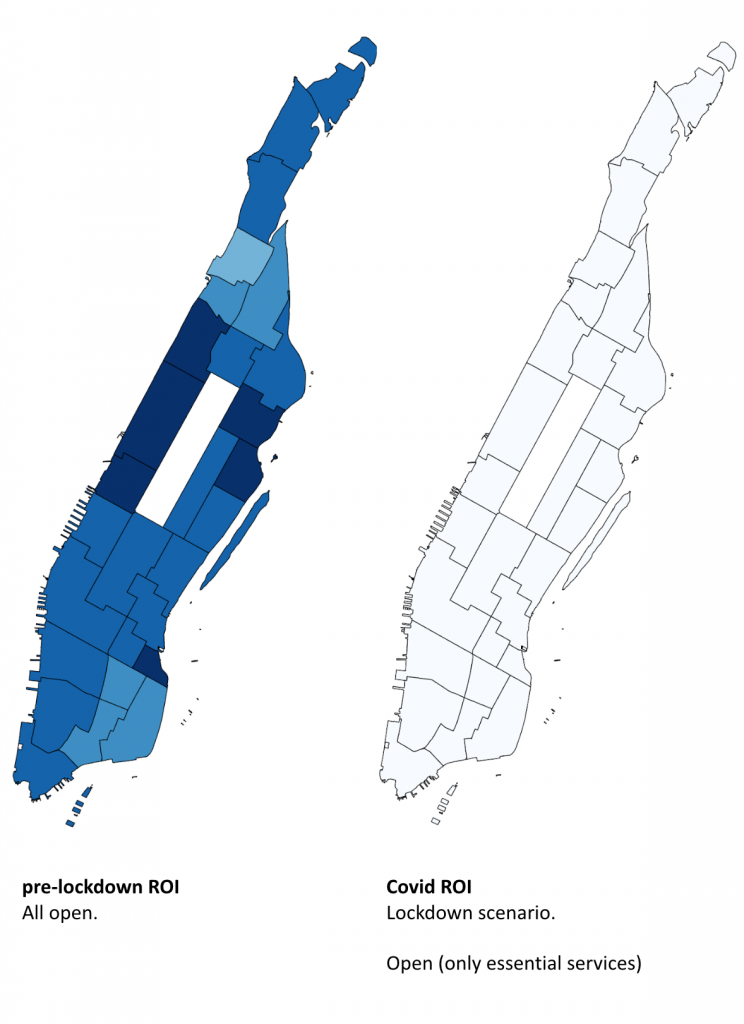
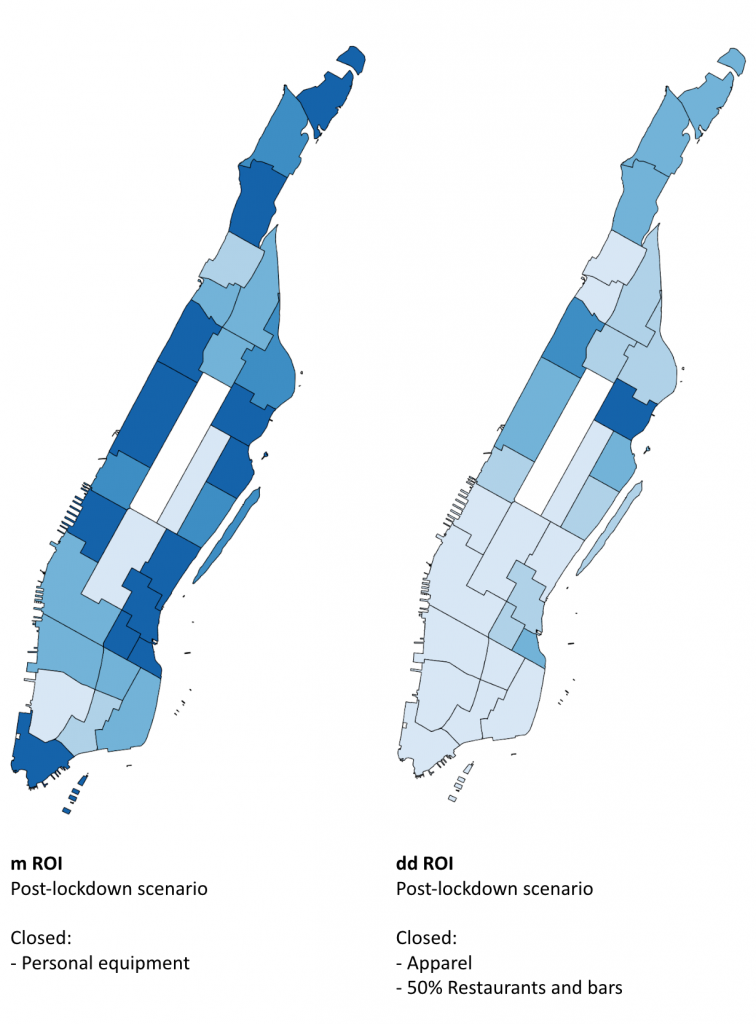
How many stores may close before it turns really ugly?
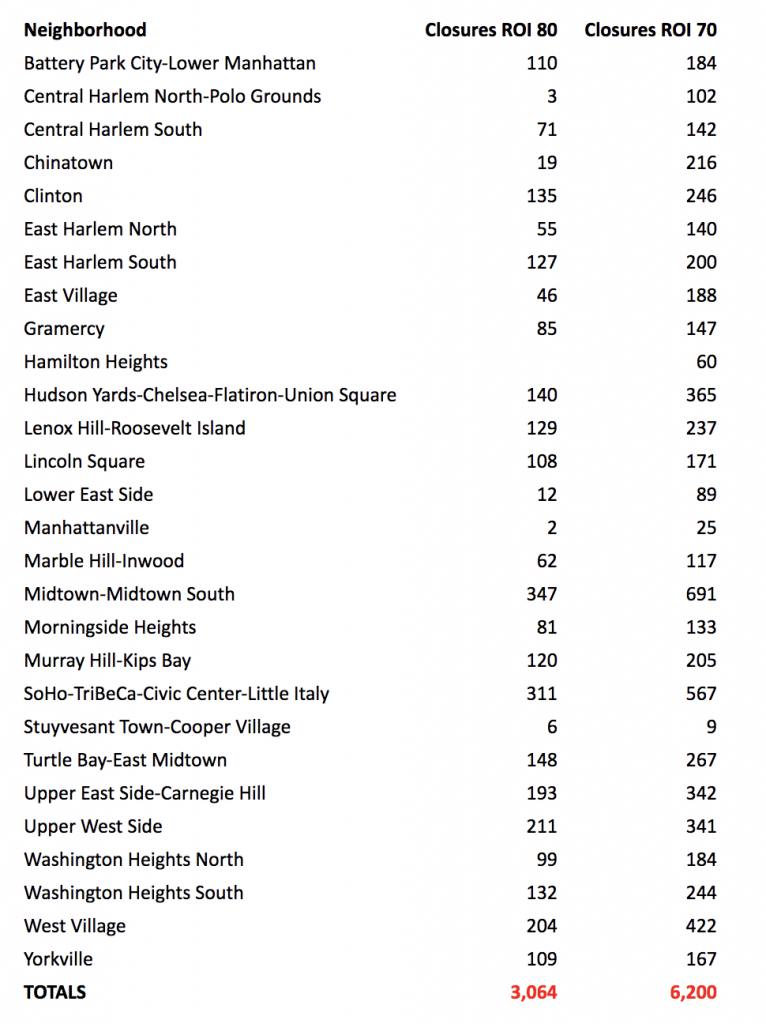
In order to keep retail occupancy at a healthy level, the ROI should be 80 or higher. However, it is especially important to at least be above an ROI of 70, which is considered the critical point for severe desertification.
Retail occupancy variation.
In order to detect the neighborhoods most affected by the massive closure of stores, and the difficulties in re-opening, we have established a “minimum leap” index that represents the variation between the current scenario and the medium impact scenario (m), where all activities are open except apparel stores.
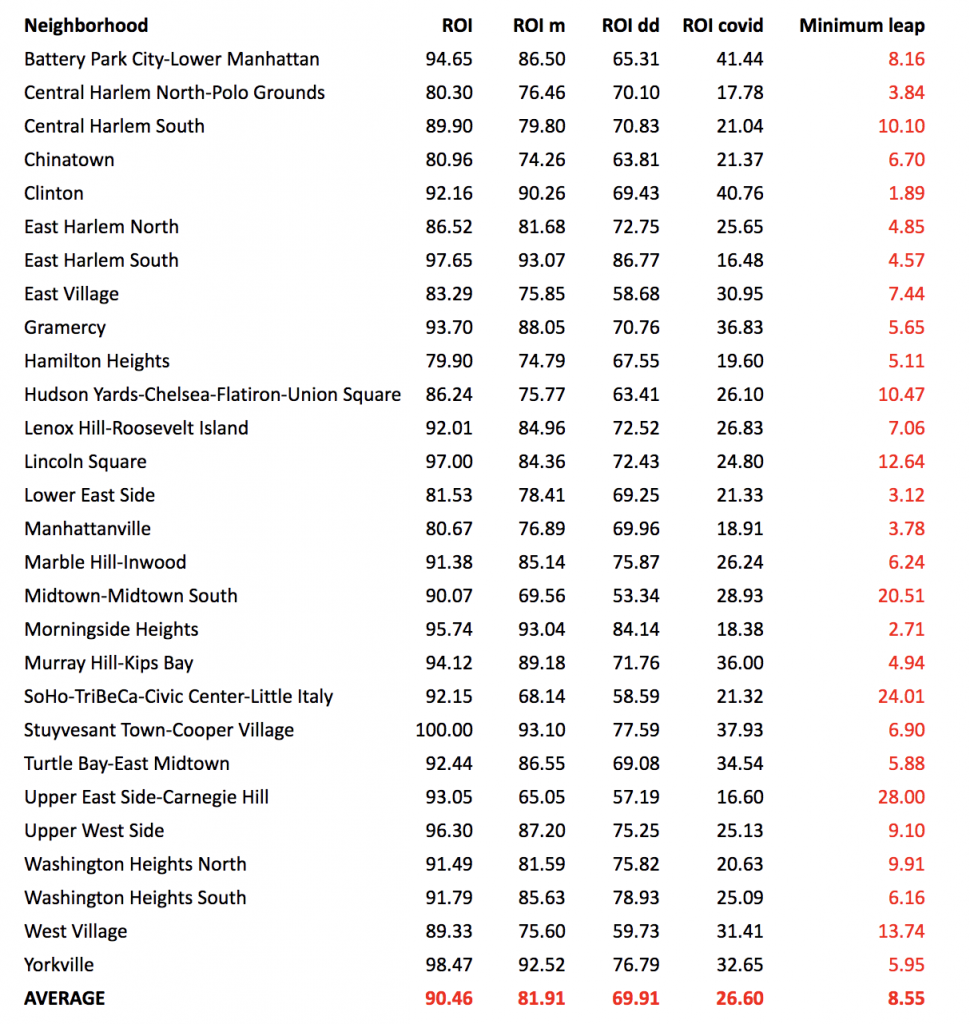
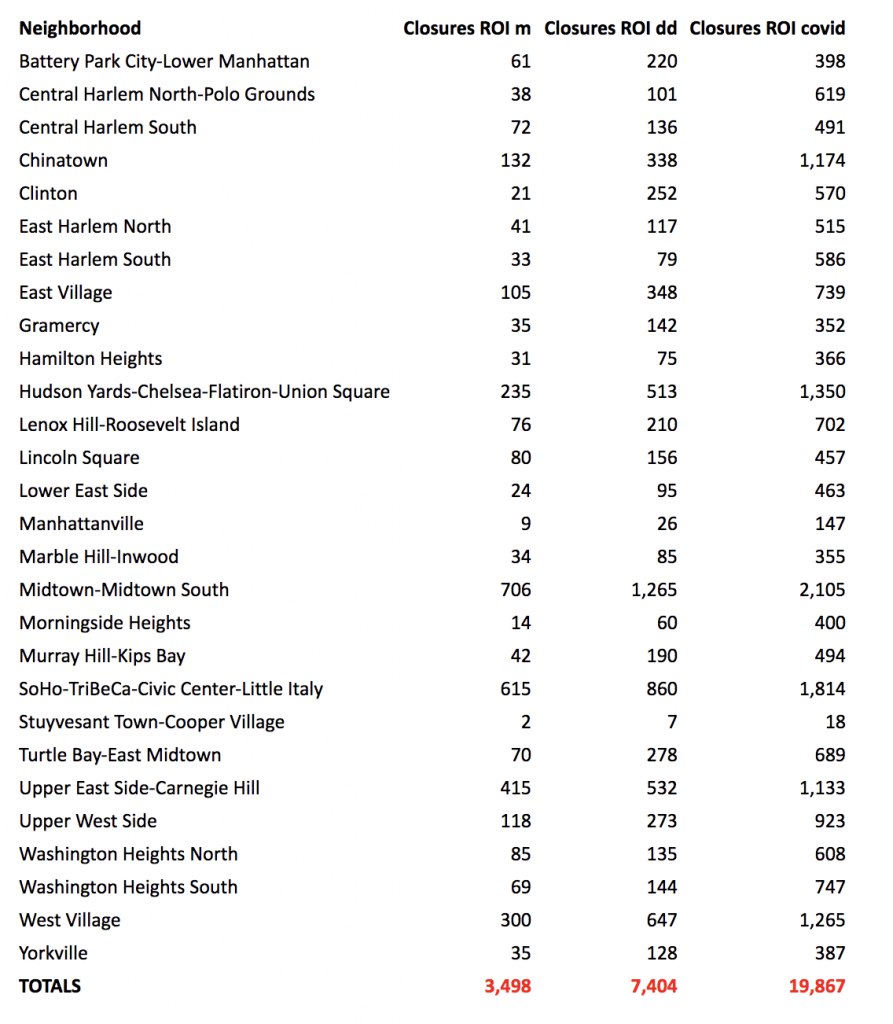
Conclusions. From minimum impact to Doomsday scenario.
We defined two post-lockdown scenarios.
One of moderate damage, moderately optimistic:
In this scenario, apparel stores (clothes, shoes, jewelry, etc.) remain closed; other activities are also affected, but less so. This is not a great scenario, as it involves the closure of between 10% and 30% of the economic activities on the groundfloor of the city. It destroys a retail model based on independent shop owners, which we define as entrepreneurs who own between one and four retail establishments.
The most damaging scenario, the Doomsday Scenario, is also plausible:
In this scenario, persistent closure seriously affects both apparel stores, as well as the restaurant and hotel industry. Given the importance of tourism in Manhattan, and the fact that tourism will not return to the pre-Covid-19 crisis levels for up to a year, this is a very realistic scenario.
But this scenario is bad not only for tourism. The norms of social distancing, which affect the social life that fills bars, restaurants and nightclubs, are here to stay. These norms can be unilaterally applied by the government at any time they see they fit, be it for health reasons or other reasons, and this possibility has to be considered.
This scenario involves 30% to 50% of the active premises remaining closed, depending on the neighborhood.
Can disaster be avoided? What to do?
Understanding that a catastrophic scenario is one that causes irreversible changes to a previous scenario, and taking into account the data we present, we find that such a scenario is very possible. Everything indicates that there will be big changes, some of which will be irreversible.
Ensuring that the medium-impact scenario (m) or better is the ultimate outcome will largely depend on how the various agents, who have the power to transform the commercial landscape, end up acting. These agents are primarily public administrations at various levels of government and decision-making, and they are key to the outcome. If these public administrations drag their feet and act late, the worst-case scenario outlined in this article, or worse, is very possible.
The doomsday or worst-case scenario could lead to the collapse of the heretofore very successful “Mediterranean city model”, as it exists in Manhattan. High levels of vacancy for extended periods of time could lead to a gradual migration of retail to a more “high-street” or “main street” model of retail, where retail is concentrated on main commercial streets (likely the avenues and primary cross streets of Manhattan). It can also lead to islands of retail desertification.
Long-term vacancy would also mean losing a lot of independent businesses that, until now, were solvent and met fundamental needs in our cities. Moreover, it will take time for future businesses to replace the shops that close during and shortly after this emergency, and any long-term vacancy problems will discourage some potential new shops from opening.
Therefore, it is necessary to take decisive action, necessarily led by the public administrations, to ensure the minimum damage to the retail sector of the borough. Among other things, businesses need support to keep their workers on the payroll, to pay their rent and loans, to move more of their business online, and to make other adjustments to their business model.
This will require accessing the resources in the federal CARES bill, as well as additional resources and assistance from the State, City, and philanthropic sector. Any and all things that can be done to support businesses in accessing these resources will be critical. The city agencies, business improvement districts, and local non-profits should all coordinate to the maximum degree possible to facilitate this access.
Retail makes a city. Without urban retail, cities, as we know them, will be something else.
Co-authors of this article:
David Nogué, architect, founder & CEO at EIXOS Economic Observatory
David Brito, city planner
Data sources:
EIXOS Economic Observatory –> Economic activities map & dataset.
NYC Open Data –> Population data.
Open Street Map –> Cartographic base.
Other references:
This space is available – NYT article by Corey Kilgannon
Barcelona COVID19 – Barcelona post-covid19 retail scenarios by David Nogué
Information on Novel Coronavirus – Governor Cuomo Issues Guidance on Essential Services Under The ‘New York State on PAUSE’ Executive Order. – by Governor of New York State

https://7filtrov
Насосы для колодцев и скважин: виды и правильный выбор.
Насосы для колодцев и скважин являются одним из главных элементов системы водоснабжения любого частного дома. Их характеристики должны позволять бесперебойно обеспечивать водой дом, а при необходимости – и полив приусадебного участка, наполнение бассейна и т.д. О их типах, отличиях и их выборе для водоснабжения дома Вы можете узнать из этой статьи.
Содержание статьи:
Критерии выбора насосов.
При выборе насоса для колодца или скважины в первую очередь необходимо учесть расстояние до уровня воды в них. Если оно небольшое – не более 8-9 метров, то можно выбрать поверхностный самовсасывающий насос или глубинный (погружной). Если же до уровня воды более 8-9 м, то практически вариант один – глубинный (погружной) .
Выбрав тот или иной вид необходимо определиться с его основными характеристиками: высотой напора и производительностью. По этим характеристикам насос подбирают в зависимости от требуемого давления в системе водоснабжения дома и необходимого расхода воды (необходимая минимальная подача).
Кроме этого, необходимо учесть расстояние от дома до колодца или скважины и гидравлическое сопротивление в трубах, узлах и запорной арматуре (вентилях, кранах и т.д.). Для компенсации гидравлических потерь необходимо выбирать насос с запасом мощности (не менее 10%).
Типы насосов для колодцев или скважин.
Можна выделить два основных вида, в зависимости от их расположения по отношению к воде:
поверхностные; глубинные или погружные.
Поверхностные устанавливаются возле источника воды или в помещении, а в воду опускается только всасывающая труба с обратным клапаном на конце. В большинстве случаев, для пуска такого насоса всасывающая труба и сам он должны предварительно заполняться водой.
центробежными (вихревыми) без эжектора, одно- или многоступенчатыми; самовсасывающими, со встроенным или вынесенным эжектором.
Поверхностные центробежные насосы без эжектора могут всасывать воду из колодца или скважины с глубины не более, чем 7-8 м. Перед их пуском обязательно необходимо заполнить всасывающую трубу водой, так как если в трубе будет воздух, он самостоятельно ее закачать не сможет. Поэтому, при использовании таких поверхностных насосов на всасывающей трубе, опускаемой в воду, обязательно необходимо установить обратный клапан, чтобы вода из системы при неработающем насосе не уходила обратно. Если клапан будет держать нормально, то всасывающая труба будет постоянно заполнена водой и при последующих пусках её уже не надо будет заливать. Кроме этого, во всасывающую трубу во время работы не должен попадать воздух.
Одноступенчатые центробежные модели отличаются простотой конструкции, надежностью и невысокой ценой. Но они отличаются и довольно высоким уровнем шума при работе. Многоступенчатые агрегаты такого типа отличаются более низким уровнем шума и меньшим энергопотреблением, при тех же параметрах подачи и напора что и одноступенчатые. Такие п оверхностные насосы для колодцев или скважин без эжектора осуществляют подачу воды благодаря специальной многоступенчатой конструкции гидравлической части. Они практически бесшумны, имеют больший КПД, что является их преимуществом .
Самовсасывающие поверхностные насосы могут быть со встроенным или вынесенным эжектором, который позволяет им подымать воду с глубины большей за 8 м. Встроенный эжектор позволяет всасывать воду, даже если в трубе есть воздух. Такие насосы обеспечивают подъем воды из скважины или колодца за счет разряжения. Их недостатком является то, что они дороже обычных центробежных (вихревых) агрегатов, а также то, что у них относительно высокий уровень шума и поэтому их целесообразно устанавливать в специальном помещении вне дома.
Модели с вынесенным эжектором практически бесшумны, так как эжектор располагается в колодце или скважине. Они могут поднимать воду с глубины до 45 м, но они более сложны в монтаже и капризны в работе. К тому же, они очень чувствительны к механическим примесям в воде (песок, ил)
Одной из важных характеристик при выборе насоса любого вида – это его номинальная подача (м 3 /час) и напор. Большинство из поверхностных насосов для водоснабжения частного дома имеют подачу в пределах 4 – 8 м 3 /час и максимальный напор до 55 м.
Как правило, именно поверхностные насосы входят в стандартный комплект насосной установки для дома – “безбашенки”.
Погружные (глубинные)
Как уже говорилось, когда уровень воды в скважине или колодце ниже 8-9 метров, то для подачи воды в систему водоснабжения дома необходимо выбирать только погружной (глубинный) насос. Хотя его вполне можно использовать и при меньшем уровне. Для подачи воды он полностью погружается в воду. Забор воды может осуществляться сверху или снизу.
При сезонных понижениях уровня воды необходимо следить, чтобы погружной (глубинный) насос всегда был в воде, иначе он выйдет из строя и придётся покупать новый. Этого недостатка лишены модели погружных насосов со специальными “поплавками” – поплавковыми выключателями, которые отключают их при критическом снижении уровня воды и предотвращают тем самым выход из строя.
Установка и монтаж глубинного насоса.
Глубинный (погружной) насос с помощью переходников и хомутов подсоединяется к трубе, подающей воду непосредственно в дом или к “безбашенке”. Выше насоса обязательно устанавливают обратный клапан того же внутреннего размера, что и труба или большего – для уменьшения гидравлического сопротивления. На корпусе обратного клапана есть стрелка направления потока воды, чтобы не ошибиться при его установке – стрелка должна быть направлена вверх – по направлению движения воды. Если обратный клапан не установить, то при выключении насоса вода из системы будет уходить обратно в колодец или скважину, так как клапаны самих насосов не всегда надежно удерживают воду в системе.
Обычно сейчас для подачи воды из скважин или колодцев используют различные пластиковые жёсткие или гибкие армированные трубы . Для водоснабжения дома необходимо использовать трубы из так называемого пищевого пластика и рассчитанные на максимальное давление, которое будет в системе водоснабжения дома с достаточным запасом прочности. Кроме этого, обычно, они требуют стабильного напряжение в электросети ( + – 5%). Как правило, обязательно необходимо устанавливать обратный клапан и защиту от сухого хода (поплавковая система, датчики уровня или другие защитные устройства).Почему не работает глубинный насос?
Какой насос выбрать для водоснабжения дома?
Сейчас в продаже имеется большое разнообразие насосов для скважин и колодцев разных производителей (как зарубежных – Pedrollo, Grundfos, Calpeda, Wilo, так и отечественных) под самые различные условия эксплуатации и требования. В последнее время много на рынке и китайской продукции. Поэтому без труда можно подобрать оптимальный вариант в соответствии с необходимыми характеристиками, качеством и приемлемой ценой. При этом лучше всего ориентироваться на известного надежного производителя, но такие модели, как правило, дороже или можно посоветоваться со знакомыми, с теми кто уже имеет опыт эксплуатации тех или иных насосов подешевле.
Источник –
насос vodotok отзывы
купить насос для пруда
Также, рекомендую –
vodotok купить и
насос для пруда на даче